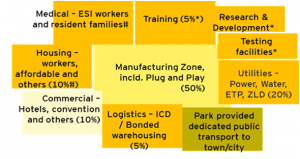INDIAN POLITY, GOVERNANCE AND SOCIAL JUSTICE
1. PRODUCTIVITY LINKED BONUS TO RAILWAY EMPLOYEES
THE CONTEXT: The Union Cabinet approved the Productivity Linked Bonus (PLB) equivalent to 78 days’ wages for the financial year 2020-21 for all eligible non-gazetted Railway employees (excluding RPF/RPSF personnel).
THE EXPLANATION:
- The financial implication of payment of 78 days’ PLB to railway employees has been estimated to be Rs.1984.73 crore.
- The wage calculation ceiling prescribed for payment of PLB to the eligible non-gazetted railway employees is Rs.7000/- p.m. The maximum amount payable per eligible railway employee is Rs. 17,951 for 78 days.
- About 11.56 lakh non-gazetted Railway employees are likely to benefit from the decision.
- Payment of PLB to eligible railway employees is made each year before the Dusshera/ Puja holidays. The decision of the Cabinet shall be implemented before the holidays for this year as background.
- Railways were the first departmental undertaking of the Government of India wherein the concept of PLB was introduced in the year 1979-80.
- The main consideration at that time was the important role of the Railways as an infrastructural support in the economy’s performance as a whole. In the overall context of Railway working, it was considered desirable to introduce the concept of PLB as against the concept of Bonus on the lines of ‘The Payment of Bonus Act -1965’.
- Even though the Payment of Bonus Act does not apply to the Railways, yet the broad principles contained in that Act were kept in view for the purpose of determining the “Wage/Pay Ceiling”, definition of ‘Salary’/’Wage’, etc.
- The PLB Scheme for the Railways came into force from the year 1979-80 and was evolved in consultation with the two recognized Federations, namely, All India Railwaymen’s Federation and National Federation of Indian Railwaymen and with the approval of the Cabinet. The scheme envisages a review every three years.
SOURCE: PIB
2. PM MITRA PARKS
THE CONTEXT: The Government has approved the setting up of 7 PM MITRA parks as announced in the Union Budget for 2021-22.
THE EXPLANATION:
- PM MITRA is inspired by the 5F vision of the Hon’ble Prime Minister. The ‘5F’ Formula encompasses – Farm to fibre, fibre to the factory, factory to fashion, fashion to foreign.
- This integrated vision will help to further the growth of the textile sector in the economy. No competing nation has a complete textile ecosystem like ours, and India is strong in all five Fs.
- The 7 Mega Integrated Textile Region and Apparel Parks (PM MITRA) will be set up at Greenfield / Brownfield sites located in different willing States.
- The PM MITRA parks will have the following:
- Core Infrastructure: Incubation Centre & Plug & Play facility, Developed Factory Sites, Roads, Power, Water and Waste Water system, Common Processing House & CETP and other related facilities, e.g. Design Centre, Testing Centres etc.
- Support Infrastructure: Workers’ hostels & housing, logistics park, warehousing, medical, training & skill development facilities
- PM MITRA will develop 50% Area for pure Manufacturing Activity, 20%area for utilities, and 10% of the area for commercial development. A schematic representation of the PM MITRA is illustrated below:

SOURCE: PIB
ENVIRONMENT, GEOGRAPHY AND AGRICULTURE
3. INDIA’S NEWEST TIGER RESERVE
THE CONTEXT: The National Tiger Conservation Authority (NTCA) approved the Chhattisgarh government’s proposal to declare the combined areas of the Guru Ghasidas National Park and Tamor Pingla Wildlife Sanctuary as a Tiger Reserve.
THE EXPLANATION:
- The new Reserve is located in the northern part of the state, bordering Madhya Pradesh and Jharkhand. This will be the fourth Tiger Reserve in Chhattisgarh, after the Udanti-Sitanadi, Achanakmar, and Indravati Reserves.
- The proposal was considered by the 11th Technical Committee of the NTCA on September 1, and approval was granted a month later under Section 38V (1) of The Wildlife (Protection) Act, 1972. (“Tiger Conservation Plan: The State Government shall, on the recommendation of the Tiger Conservation Authority, notify an area as a tiger reserve.”)
- The Tamor Pingla Wildlife Sanctuary was identified as part of the Sarguja Jashpur Elephant Reserve in 2011.
- The Guru Ghasidas National Park used to be part of the Sanjay National Park in undivided Madhya Pradesh. Both were identified as reserve forests and had been in line to be notified as Tiger Reserve since 2011.
- Guru Ghasidas National Park was the last known habitat of the Asiatic cheetah in the country.
- Originally part of the Sanjay Dubri National Park, Guru Ghasidas Park was created as a separate entity in Chhattisgarh’s Sarguja region after the formation of the state in 2001.
- Wildlife experts and activists believe that turning Guru Ghasidas into a Tiger Reserve is essential because it connects Jharkhand and Madhya Pradesh and provides a corridor for tigers to move between the Bandhavgarh and Palamau Tiger Reserves.
- Bhoramdeo, on the other hand, connects the Indravati Tiger Reserve in Chhattisgarh with the Kanha Tiger Reserve in Madhya Pradesh and, experts say, the decision to create a Tiger Reserve at Guru Ghasidas National Park should not affect attempts to notify Bhoramdeo as a Tiger Reserve too.
SOURCE: IE
INDIAN ECONOMY
4. COAL SHORTAGE
THE CONTEXT: India’s thermal power plants face a severe coal shortage, with coal stocks coming down to an average of four days of fuel across an increasing number of thermal stations. Union Power Minister has said that while the supply crunch has not yet led to any power cuts in the country, the coal supply situation is likely to be “uncomfortable” for up to six months.
THE EXPLANATION:
- The average level of coal stocks at an increasing number of India’s thermal power plants have come down to four days’ worth of stock compared to the government recommendation that thermal power plants hold 14 days’ worth of coal stock.
- India’s coal-fired thermal power plants account for 208.8 GW, or 54 per cent of India’s 388 GW installed generation capacity.
- As the economy recovers from the Covid-19 pandemic coupled with supply issues, a sharp uptick in power demand has led to the current coal shortage.
- Coal-fired thermal power plants have also supplied a higher proportion of the increase in demand leading to the share of thermal power in India’s power mix increasing to 66.4% from 61.9% in 2019.
- The government has connected an additional 28.2 million households, and these households are buying lights, fans and television sets, leading to an increase in power demand.
- The trend for higher daily demand continues with total demand for power in the country hitting 174 GW on October 4, up 15 GW from the same day in 2020.
- Other key reasons for the supply crunch include lower than normal stock accumulation by thermal power plants in the April-June period and continuous rainfall in coal-bearing areas in August and September, leading to lower production and fewer despatches of coal from coal mines.
- A consistent move to lower imports coupled with high international prices of coal has also led to plants cutting imports.
- An inter-ministerial team, including representatives of the Power and Railway Ministries, Coal India Ltd, the Central Electricity Authority and Power System Operation Corporation, monitors the supply of coal to thermal power plants.
- The government is pressing thermal plants with captive coal mines to boost their coal output to meet more of their demand. It is also prioritizing coal supplies for thermal power plants with low stock levels.
- The Power Ministry is also trying to increase the coal supply by expediting the start of production from several mines that already have all requisite clearances in place.
SOURCE: IE
5. MOODY UPGRADED INDIA’S SOVEREIGN RATING OUTLOOK
THE CONTEXT: Asserting that India’s downside risks from negative feedback between the real economy and financial system are receding, rating agency Moody’s changed India’s sovereign rating outlook from ‘negative’ to ‘stable’, while affirming the country’s foreign-currency and local-currency long-term issuer ratings at Baa3.
THE EXPLANATION:
- Last year, Moody’s downgraded India’s sovereign rating from ‘Baa2’ to ‘Baa3’, the lowest investment grade, saying there will be challenges in implementing policies to mitigate risks of a sustained period of low growth and deteriorating fiscal position. The outlook on the rating was kept negative.
WHAT LED TO AN UPGRADE IN THE RATING AGENCY’S OUTLOOK?
- Banks and non-bank financial institutions pose a much lesser risk to the sovereign with higher capital cushions and greater liquidity than Moody’s previously anticipated.
- While risks stemming from a high debt burden and weak debt affordability remain, Moody’s expects that the economic environment will allow for a gradual reduction of the general government fiscal deficit over the next few years, preventing further deterioration of the sovereign credit profile.
WHAT IS MOODY’S ASSESSMENT OF GROWTH?
- Following a profound contraction of 7.3 per cent in the fiscal year ending March 2021, India’s real GDP is expected to surpass 2019 levels this fiscal year, rebounding to a growth rate of 9.3 per cent, followed by 7.9 per cent in fiscal 2022.
- Looking ahead, Moody’s expects real GDP growth to average around 6 per cent over the medium term.
- Some analysts argued that Moody’s had underestimated India’s potential of natural GDP expansion in the medium term, as there are enough levers for higher growth.
WHAT IS THE IMPACT OF THE UPGRADE?
- Since overseas borrowing costs are tied to a country’s rating and the agencies’ outlook on the nation, an upgrade usually helps lower borrowing costs for the government and the corporate sector.
- With chances of default receding and improvement in overall debt serviceability, foreign investors take comfort in subscribing to government and corporate bonds at lower rates.
SOURCE: IE
SCIENCE AND TECHNOLOGY
6. DEEP BRAIN STIMULATION
THE CONTEXT: Physicians at the University of California, San Francisco (UCSF) have successfully treated a patient with severe depression by recognizing and tapping into the brain circuits linked with depressive brain patterns.
THE EXPLANATION:
- The work, which represents a landmark in the use of neuroscience to treat psychiatric disorders, has been published in the journal Nature Medicine.
- The doctors used an existing technique called deep brain stimulation (DBS), customizing it for this patient’s case. DBS is a surgical procedure in which electrodes are implanted into certain brain areas.
- These electrodes, or leads, generate electrical impulses that control abnormal brain activity.
- Conditions that are traditionally treated using DBS include dystonia, epilepsy, essential tumour, obsessive-compulsive disorder and Parkinson’s disease. In treating depression, however, previous clinical trials with DBS have shown limited success because most devices can only deliver constant electrical stimulation to one area of the brain, UCSF noted in a press release.
- During this treatment, UCSF physicians customized a new DBS device, stimulating the brain whenever it recognized the depressive pattern.
- Additionally, the team of physicians had also found a neural biomarker that indicated the onset of symptoms. Using the customized DBS device, they stimulated a different area of the brain, which in turn created immediate therapy for the brain.
SOURCE: IE
7. NOBEL PRIZE 2021 IN CHEMISTRY
THE CONTEXT: German Benjamin List and Scottish-born David MacMillan won the 2021 Nobel Prize in Chemistry to develop asymmetric organocatalysis, a “new and ingenious tool for molecule building”.
THE EXPLANATION:
- Organic catalysts can be used to drive multitudes of chemical reactions. Researchers can now more efficiently construct anything from new pharmaceuticals to molecules that can capture light in solar cells using these reactions.
- These catalysts were both environmentally friendly and cheap to produce.

SOURCE: IE
8. WHO RECOMMENDS THE FIRST ANTI-MALARIAL VACCINE
THE CONTEXT: In a historic move, the World Health Organization (WHO) endorsed the first anti-malarial vaccine, as mankind enters a key turning point in a battle waged relentlessly over decades between man and mosquito, the vector.
THE EXPLANATION:
- It was recommending the widespread use of the RTS,S/AS01 (RTS,S) malaria vaccine among children in sub-Saharan Africa and other regions with moderate to high P. falciparum malaria transmission
- It is based on results from an ongoing pilot programme in Ghana, Kenya and Malawi.
- The development comes when the WHO and its partners have reported stagnation in progress against the disease that kills more than 2,60,000 African children under the age of five annually.
- Malaria remains a primary cause of childhood illness and death in sub-Saharan Africa, according to the WHO.
SOURCE: TH
MISCELLANEOUS
9. HENLEY PASSPORT INDEX
THE CONTEXT: India’s rank has slipped by six places from last year to 90 on the Henley Passport Index, which lists the world’s most travel-friendly passports.
THE EXPLANATION:
- Prepared by Henley and Partners, a London-based global citizenship and residence advisory firm, the Henley Passport Index claims to be the “original ranking of all the world’s passports”. The index covers 227 destinations and 199 passports.
- The Henley Passport Index comes when countries are easing travel rules for international visitors after almost two years since the onset of the Covid-19 pandemic.
- The index ranks countries’ passports according to the number of destinations their holders can visit without a prior visa. The rankings are based on the analysis of the International Air Transport Association (IATA) data.
- Japan and Singapore stood at the top of this year’s list, with their passports holders allowed to travel visa-free to 192 countries, while South Korea and Germany share the second position. For the third consecutive year, Japan has secured the top position. Meanwhile, Afghanistan, Iraq, Syria, Pakistan, and Yemen are among the least powerful.
- India, which held the 84th rank last year, fell to the 90th position, with its passport holders allowed to travel visa-free to 58 countries. India shares the rank with Tajikistan and Burkina Faso.
SOURCE: IE
PRELIMS PRACTICE QUESTION
Which of the following can notify an area as a tiger reserve?
a) Local Authority
b) State Government
c) National Board for Wild Life
d) National Tiger Conservation Authority
ANSWER FOR OCTOBER 6, 2021 PRELIMS PRACTICE QUESTIONS (REFER TO RELEVANT ARTICLE)
ANSWER: C)
Explanation
- Senkaku islands – East China Sea
- Paracel islands – South China Sea
- Diego Garcia – Indian Ocean


